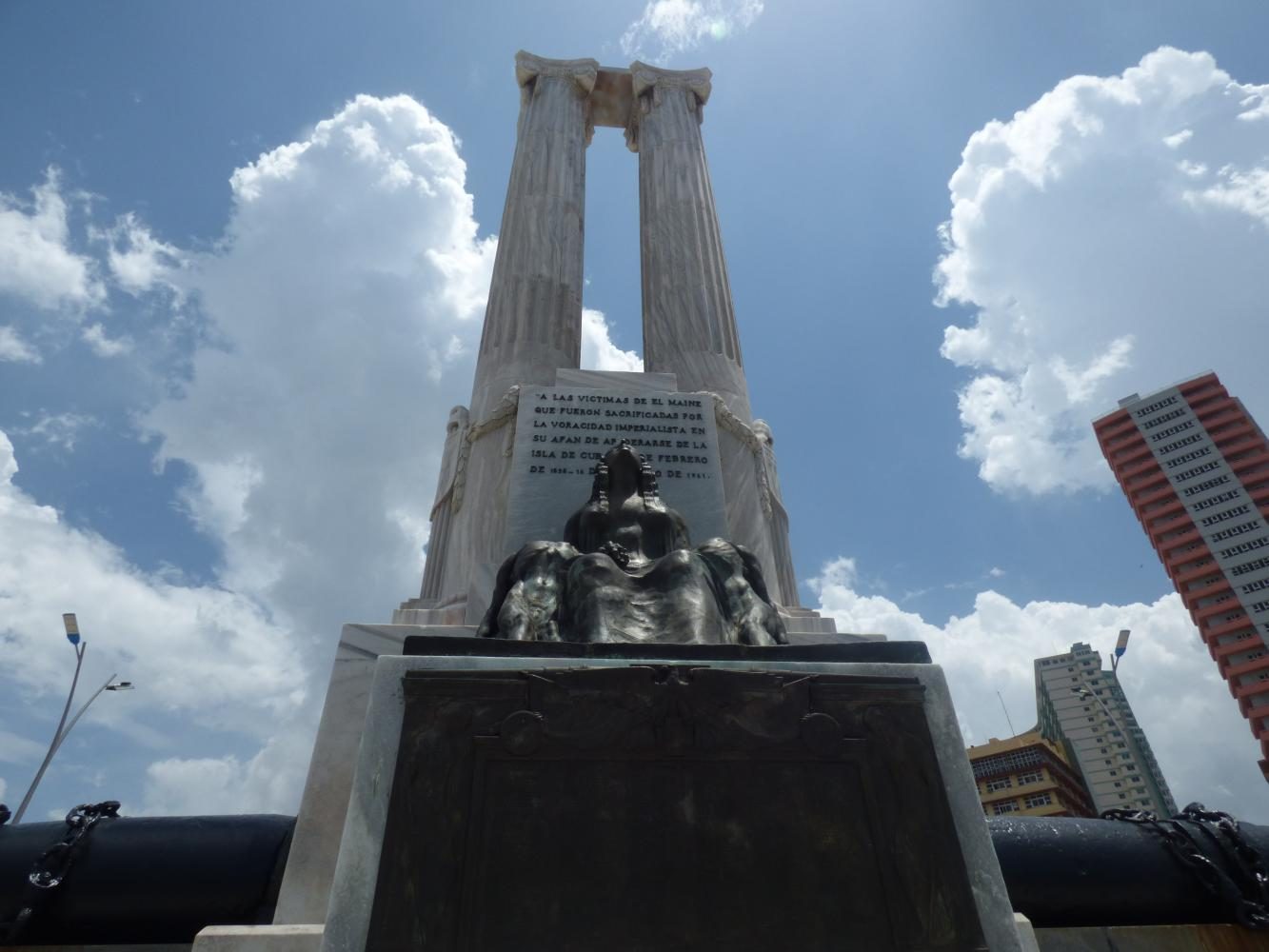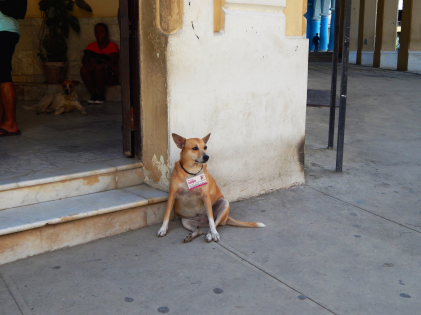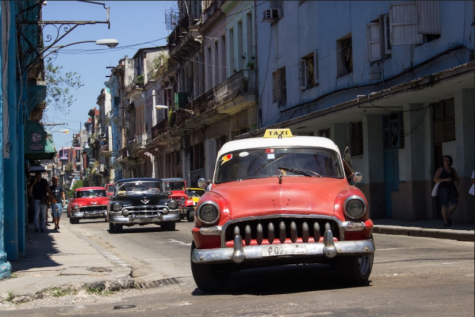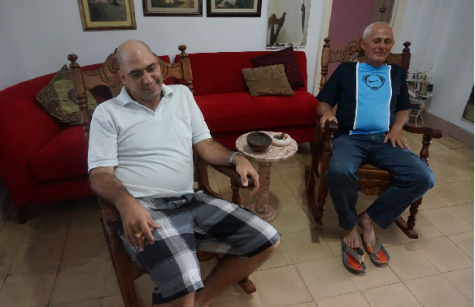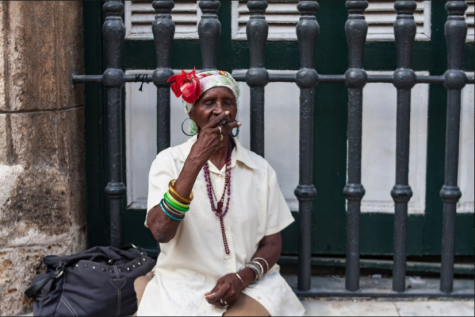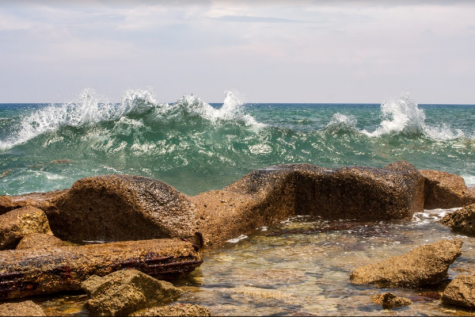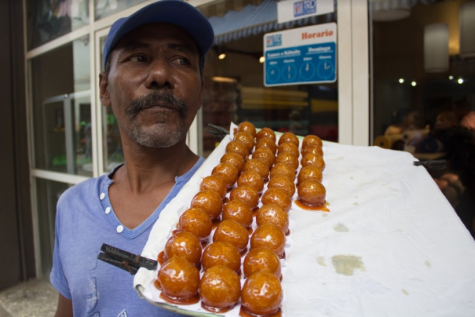“Patria o muerte:” Anti-colonial history and Cuba’s place in Latin America
August 28, 2017
In a forest of banner-less flagpoles, there stands a wall, a wall that boldly displays three simple yet powerful words in bright red: “¡Patria o muerte!” Even more curious than its placement amongst the aforementioned flagpoles, however, is what building this wall is directly facing. Head past the poles and across the street, and you’ll find yourself at the U.S. Embassy in Havana. In a funny and not so subtle way, the wall openly challenges the embassy; a testament to the deep history and tense relationship between two governments.
The island of Cuba, only 90 miles off the coast of Florida, has been an anomaly for almost 60 years. Not an anomaly of economic development or global isolation mind you, but rather an anomaly in a part of the world that it shares many similarities with. Even within Latin America, Cuba stands alone.
Along with this, Latin America in itself is a region of contrast. On one hand, sovereign countries and governments in Central and South America claim to be independent and free from foreign control, able and willing to do as they please. Yet at the same time, many of the population would argue that the history of foreign economic dealings, both past and present, would paint a very different picture.
20th century Latin America was littered with numerous uprisings by all kinds of different rebel groups and at the same time, CIA-backed government coups, both of which have affected the political landscape of the region even today. Cuba is, of course, more famous for its Revolution of 1959 which changed the Western Hemisphere forever.
What makes Cuba even more interesting is that it was, in fact, the last of the Latin American countries to gain independence from the colonial rule of Spain.
While most other countries of the region declared independence in the early parts of the 19th century, Cuba wouldn’t be able to shake off the Spanish crown until the dawn of the 20th. This may not seem like a large gap but to put it into perspective, imagine if the United States hadn’t gained independence from Great Britain until after India had. That alone should sound like a crazy idea.
On top of this, Cuba without a doubt has been the biggest thorn in the side of foreign corporate interests in the region as well. It’s no secret that like other parts of Latin America, Cuba is prime real estate when it comes to the business of agriculture.
Sugar? Forget about it, Cuba has some of the best and richest lands for it. Coffee? Same deal. Tobacco? Oh boy, are you kidding me? Cuba was the most sought-after piece of land for all these purposes. The Spanish recognized this over 500 years ago and everyone else certainly hasn’t forgotten about it since it 1898.
While other Latin American countries celebrate their independence days as things of the past, Cuba is a land that still believes it is in the midst of a revolution that will continue until everyone else sees and treats it for what it is: independent.
Cuba’s long history of anti-colonialism/imperialism also reaches farther than mere text in a history book as it has become deeply ingrained within the culture. Most make the mistake of only focusing on the Revolution and to a degree, this is understandable. After all, it’s hard to not walk around almost every corner and see monuments or murals commemorating the Revolution of 1959 that famously propelled Castro to the forefront of Latin American politics. For instance, Che Guevara’s face seemingly gazes upon you from every direction: T-shirts hanging in small businesses, paintings, photographs, slogans all adorned with his portrait, eyes still burning with angst for the proletariat’s rise against the bourgeoisie and the liberation of the Latin American people.
Yet Cuba also celebrates the revolutions of other Latin American countries as well, a touching gesture that took me aback when I really thought how different that was. After all, I don’t remember there ever being a monument to someone like famous French revolutionary Robespierre here in the U.S. (I could be wrong here, and there very well could be one in which case I’ll gladly eat my own words.) Anyways, I digress.
Some examples of honored revolutionaries include the likes of Hugo Chavez, former president of Venezuela who is immortalized through murals often depicting him in the same light as Fidel. Some streets are also named after key Latin American leaders such as Emiliano Zapata, who led Southern Mexico in the revolution of 1910, and Salvador Allende who was Chile’s first democratically elected Marxist President; both of whom would achieve martyr status after being executed through nefarious means.
To be sure, the revolution of 1959 is without a doubt the most celebrated and memorialized in Cuba for obvious reasons, but I was surprised to see how much it commemorated leaders and rebellions of other Latin American countries.
The Cuban Revolution, or rather the Triumphant Revolution as it is called by some, was, in fact, a culmination of numerous movements for independence that came over centuries before.
Stretching as far back as Cuba’s very beginnings, the Native Taino people, who were essentially wiped out by Spanish rule, openly defied Spain. Not surprisingly, Cuba still celebrates this seemingly forgotten past with the display of Hatuey, the rebel leader of the Taino, who led a revolt only to be burned at the stake. His profile can still be seen on the famous Cohiba brand of cigars that are so sought after by the rest of the world as well as a broad range of other products and knick-knacks that line up Cuban souvenir shops.
Ever since, Cuba has had a long list of revolutionary figures that influenced one after the other, each losing their lives in combat or other means all in the struggle against colonial rule.
This line of revolutionaries often overshadows one another in the long narrative that is Cuba.
Perhaps the most important or at least most influential of all these revolutionaries, however, is the 19th-century author and political figure, Jose Marti. Marti is an interesting figure for many reasons, but what is more striking among them is the fact that he is widely known and at the same time widely unknown to many outside Latin America. Marti lost his life only 50 years prior to the Spanish American war leading a failed uprising but, he would end up becoming a martyr who influenced many other Latin Americans who continued to fight for everything from equal rights to land reform and everything in between.
It should be noted that beyond Marti’s fight against the Spanish, he was also keen on emphasizing the dangers of having another colonial power take Spain’s place, specifically referring to the United States. and its growing embrace of expansionism which would later manifest as imperialism in the late 19th century.
Marti’s words would prove prophetic in more ways than one. For instance, the Spanish-American War and its aftermath (often forgotten or overlooked in United States history courses) is a testament to Marti’s perceptive analysis of all future fights for independence. The war itself has been scrutinized only in recent memory as there is ample evidence to suggest that it was started under false pretenses. The explosion that sunk the USS Maine over a century ago was actually more likely due to a malfunction within the ship itself rather than a blatant act of aggression by Spanish forces in Cuba. With the help of U.S. newspaper tycoons such as William Randolph Hearst, the tragedy that was The Maine was exploited and became a rallying cry for popular support to liberate or even annex Cuba through war.
The result would be something between both options of liberation and annexation. U.S. forces were unsurprisingly successful in driving out Spain and at first, it appeared as though Cuba would retain sovereignty and be treated as an equal. However, increased monetary interest in Cuba would dictate otherwise.
Enter the Platt Amendment. This is easily the most remembered piece of U.S. foreign legislation in Cuba. Even today, Cuban tour guides, intellectuals and other random Cubans alike would recount the effects of the Platt Amendment when I asked about U.S. and Cuba relations. For those who don’t know, the Platt Amendment was added to the Cuban constitution after the Spanish American war. In the simplest of terms, the amendment basically stated that the U.S. could interfere in Cuban politics if and whenever it felt that its own interests were being challenged in the region.
It didn’t take long for this amendment to be put into practice and lo and behold, Cuba ended up with its other most infamous dictator, Fulgencio Batista who achieved power through a coup in 1952. Under Batista, Cuba essentially became a neo-colony that served whatever monetary purpose it could.
In a larger context, Cuba really wasn’t much different from the rest of Latin America save for a few minor differences. For one, income from the United States came from not only legal business entities but also large criminal enterprises as well (see Godfather II for further reference). The second major difference intertwines with the previous segment about the Platt Amendment in that the U.S. government did not have authority to meddle in other Latin American countries like it had in Cuba.
This lack of authority was treated as a minor technicality, however, as it did not stop foreign interference in the slightest. Take for instance Guatemala in 1954. To say that there are parallels between Guatemala and Cuba in the 50s would, in fact, be an understatement.
Like Cuba, Guatemala and other Latin American countries had also been subject to United States interference on a massive scale after U.S. business interests felt they were in jeopardy. More specifically, this “threat” came in the form an agrarian reform law which hoped to redistribute property more evenly amongst the Guatemalan working class. Alas, this all came to a crashing halt after CIA backed forces overthrew Guatemalan President Jacobo Arbenz and sent Guatemala through a chaotic 20th century which included a 30-year civil war and even genocide.
Coincidently (or not really), agrarian reform in Cuba would also be the final straw that severed ties between the United States government and Castro’s Cuba in the 60s.
The reason agrarian reform was deemed a “red flag” in the eyes of Washington was the simple fact that it would have confiscated and sold lands that were mostly owned by corporations like United Fruit, who owned a disproportionate amount of agricultural resources throughout the region. Take away their lands and decrease cash flow, and you have the two main ingredients of a desperate company who will do anything keep the status quo. Add in people with ties to the said company with power, such as John Foster and Allen Dulles (then Secretary of State and director of the CIA respectively), and you have a recipe for one of the biggest operations of undermining democracy in the 20th century.
It was on this same platform Batista rose to power in Cuba. Were you in need of a strongman to purge those pesky Commies, Batista would’ve been your guy.
Guatemala was unfortunately just the first in a line of Latin American Nations that would lose sovereignty through foreign interference. A brief list which includes but is not limited to:
- Chile: openly socialist President Salvador Allende would be assassinated in 1970 by CIA-backed dictator Augusto Pinochet.
- Nicaragua: U.S.-funded trained death squads known as the “Contras” would conduct terror attacks and other human rights violations. U.S. also funds the fiercely anti-communist Somoza family who rules Nicaragua for 43 years.
- El Salvador: U.S.-funded Salvadorian death squads against revolutionary guerrillas in the name of anti-communism
If you’re noticing a trend here, bravo. But this is also where we need to look at Cuba for what it truly is in this context: unique.
To further understand what made Cuba so unique and how it continues to be, I was able to interview Joaquin Santana, a University Professor of Latin American History and thought in Havana.
For starters, the interview was quite intimidating when I first thought about. As a proud Latin American, my Spanish is so-so at best. On top of this, despite my knowledge of this particular subject, I was worried that I was still woefully unprepared to converse with a professor from Latin America. I wondered, “Are my questions good enough? Did I even know enough? Oh god, did I have homework to turn into this guy? Wait, he’s not my professor. Aw, Crap.”
Luckily enough, he had the patience of a wise sage and a welcoming attitude to match. We talked openly for quite a while, and he recounted to me Cuba’s long history of anti-colonial sentiments (see above for condensed version).
I was first curious about what he thought of Cuba’s place in Latin America and whether or not it was a leader in the area of anti-colonial/imperialism.
“I believe so, yes”, he answers without hesitation. “In the first half of the 20th century, it wasn’t. But at the end of the 19th century, figures like Marti represented the ideals of not just Cuba but all of Latin America with his call for a united Latin America.”
I pressed on by asking him what other Latin American nations can learn from Cuba by revolutionary means.
“The answer to this is rather complex as every country is different. The first step would be to have a unifying philosophy which in Latin America’s case usually revolves around Marxist ideals. However, this particular vision of the revolutionary path is impossible with the presence of U.S. imperialism. The triumphant revolution of Cuba had no party but separate movements, the most famous of course being the July 26th movement, but all movements worked together. Secondly, there needs to be help from the army or a lack of foreign intervention. In Cuba, the revolution is still ongoing.”
The last part of his explanation struck me a bit, as most would view the Revolution as being one singular event. However, one needs to understand that Revolutions are quite the opposite; they are processes that can take years to come to fruition. The uprising of the July 26th movement was simply the first step of the Revolution in Cuba.
I then asked whether or not he believed that the rest of Latin America was still colonized to an extent.
“It depends on the country. There are different kinds of colonial rule. Some countries may have independent relations with stronger countries while others are totally dependent on them. In the 60’s, other movements drew upon independence theory, but the theory in itself is really complex with different concepts in many different branches.”
In other words; despite the fact that Latin American nations may share numerous similarities with one another, they are still unique within their own situations. They may or may not be totally independent on a geopolitical/economic scale but they are certainly more independent from one another than I had previously thought.
Our interview and the ensuing conversation shed some much-needed light as to what makes Cuba so special in Latin America from a Cuban perspective. Perhaps the greatest misconception about Cuba and its Revolution is that it was forged from the political fires of Socialist philosophy. To an extent this is true but the reality is that this philosophy played a minimal role in Cuba in the first stage of the revolution.
The underlying cause for most of these revolutions in Latin America is, to my mind, more rooted in the want of economic and national independence. When most of these lands are reaped for their benefits by overseas investors and business conglomerates while the country itself sees little to none of said benefits, the want for change becomes rampant amongst the exploited who work hard and receive nothing.
In the end, Cuba was able to seize its own destiny for better or for worse. What remains to be seen is whether or not Cuba will continue this revolutionary path and whether or not other Latin American nations can find it within themselves to follow.




